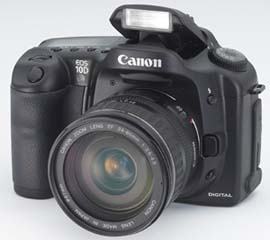As growing numbers of professional photographers recognize the need to go digital, two leading makers of professional-grade digital SLRs are touting new technical features that take into account some of the unique demands of digital photography.
Olympus All-Digital SLR System Uses Optimized Lenses: Later this month Olympus will formally announce their first 100% all-digital SLR system, including interchangeable lenses designed specifically for digital photography. Expected to roll out this fall, the camera system incorporates new Four Thirds Digital Standards that will make it possible for photographers to mount digital lenses made by one camera manufacturer onto digital camera bodies made by other manufacturers.
When conventional 35mm film lenses are used with digital cameras, insufficient light at the edges of the image sensor can result in reduced color definition–particularly when shooting with wide-angle lenses. According to Olympus America's John Knaur, “The Olympus Digital SLR System is the ultimate light-mastering digital camera system, offering professional photographers powerful advantages in terms of image quality, camera and lens size, durability, and speed.”
”
Four prototype lenses are scheduled for the rollout demonstration: 300mm, f2.8 (600mm equivalent), 14-54mm, f2.8-f3.5 zoom (28-108mm equivalent), 50mm macro, f2.0 (100mm equivalent), and 50-200mm, f2.8-f3.5 zoom (100-400mm equivalent). More detailed specs on the camera system will be available later in June. (Olympus America: www.olympusamerica.com).
Canon Promotes Specialized Processor of EOS 10D: When Canon rolled out their under-$2000 EOS 10D digital SLR earlier this year, they promoted the fact that they were the only digital-camera manufacturer that had designed and produced their own image sensor, image processor and optics. They emphasized that image quality isn't strictly a function of resolution, but rather results from the efficient inter-workings of the sensor, image processor and optics.
Canon's EOS 10D features a proprietary image processor called DIGIC (Digital Imaging Integrated Circuit) that combines the jobs of image processing and camera function control into one chip. This makes it much faster than digital cameras that use the same types of processing units used for video games, word processors and computer spreadsheets. For example, the DIGIC image processor employs parallel processing instead of the sequential, one-pixel-at-a-time processing used in most conventional digital cameras. DIGIC also can handle most digital camera functions including JPEG compression/expansion, memory card control, auto exposure, and auto white balance control. According to Canon, the DIGIC allows the EOS 10D to offer nine consecutive frames (compared to eight frames in the EOS D60) and the battery lasts more than 30% longer.
Other specs of the EOS 10D include: a 6.3 mpxl CMOS sensor, a seven-point autofocus system, three frames/sec drive speed in nine-frame bursts in JPEG or RAW+JPEG capture settings, an extended ISO range of 100 to 3200, manual white balance mode, selectable color space options (including Adobe RGB and sRGB), a scrollable 10X zoom playback mode, intelligent orientation sensor, a camera body constructed with rigid magnesium and a plug and play USB interface.
The EOS 10D also supports EXIF 2.2, DPOF 1.1, FAT32, and Compact Flash Type I and II, and is completely compatible with all EF-series lenses. The camera provides direct connectivity to several Canon Bubble Jet Direct printers and the CP-100 Card photo printer.
In addition, the EOS 10D can be used with Phase One's Capture One DSLR Limited Edition workflow management software for Windows. The software allows a range of image adjustments such as gray balance, levels/curves, contrast, crop, sizing, unsharp masking to be carried out in one process with instant feedback on the screen. A straightforward workflow provides instant feedback on all adjustments. The user-friendly interface makes it easier to prepare images for print and batch processing. (Canon USA: www.usa.canon.com; Phase One: www.phaseone.com)
Advertisement


 VEHICLE WRAPS + GRAPHICS3 weeks ago
VEHICLE WRAPS + GRAPHICS3 weeks ago
 Press Releases3 weeks ago
Press Releases3 weeks ago
 Case Studies3 weeks ago
Case Studies3 weeks ago
 Case Studies1 week ago
Case Studies1 week ago
 Benchmarks3 weeks ago
Benchmarks3 weeks ago
 Press Releases2 months ago
Press Releases2 months ago
 Press Releases3 weeks ago
Press Releases3 weeks ago
 Press Releases2 months ago
Press Releases2 months ago












